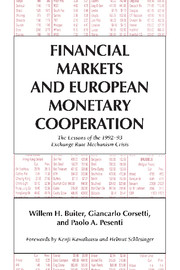 Financial Markets and European Monetary Cooperation
Financial Markets and European Monetary Cooperation Published online by Cambridge University Press: 06 July 2010
Capital market liberalization and “convergence plays”
The goal of this chapter is to complement the narrative of the 1992–93 events by focusing on the behavior of international financial markets. The recent literature has devoted considerable efforts to analyzing determinants and dynamics of ERM credibility as perceived by market participants and reflected in movements in asset prices as well as in the composition of financial portfolios. Section 4.1 presents a few relevant stylized facts characterizing European capital flows. Section 4.2 reviews the most common measures of ERM credibility. After discussing the performance of those measures, Section 4.3 addresses to what extent financial markets were able to anticipate the 1992–93 crises.
In the policy and academic debate, the coexistence of exchange rate stability and free capital mobility in Europe has long been regarded as problematic, if not impossible. In the late 1980s, many analysts shared a deep skepticism regarding the medium-term stability of the ERM. The process of liberalization, as traced in the European Council Directives 86/566 and 88/361, was expected to increase the vulnerability of weak currency countries to rapid capital outflows, thus raising the probability of a crisis.
The emphasis on the disruptive potential of capital mobility is the straightforward corollary of the consensus view that attributed a key role to capital controls (most prominent in France and Italy) in maintaining exchange rate stability in Europe during the 1980s. The rationale for restricting capital mobility is often presented in terms of a simple application of a standard open-economy model à la Mundell-Fleming.
To save this book to your Kindle, first ensure [email protected] is added to your Approved Personal Document E-mail List under your Personal Document Settings on the Manage Your Content and Devices page of your Amazon account. Then enter the ‘name’ part of your Kindle email address below. Find out more about saving to your Kindle.
Note you can select to save to either the @free.kindle.com or @kindle.com variations. ‘@free.kindle.com’ emails are free but can only be saved to your device when it is connected to wi-fi. ‘@kindle.com’ emails can be delivered even when you are not connected to wi-fi, but note that service fees apply.
Find out more about the Kindle Personal Document Service.
To save content items to your account, please confirm that you agree to abide by our usage policies. If this is the first time you use this feature, you will be asked to authorise Cambridge Core to connect with your account. Find out more about saving content to Dropbox.
To save content items to your account, please confirm that you agree to abide by our usage policies. If this is the first time you use this feature, you will be asked to authorise Cambridge Core to connect with your account. Find out more about saving content to Google Drive.